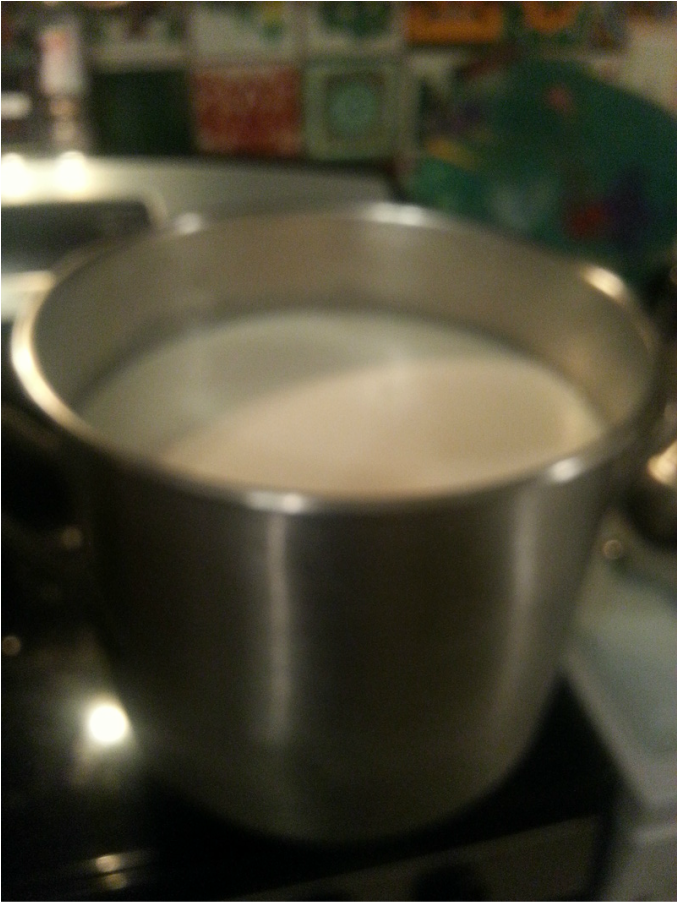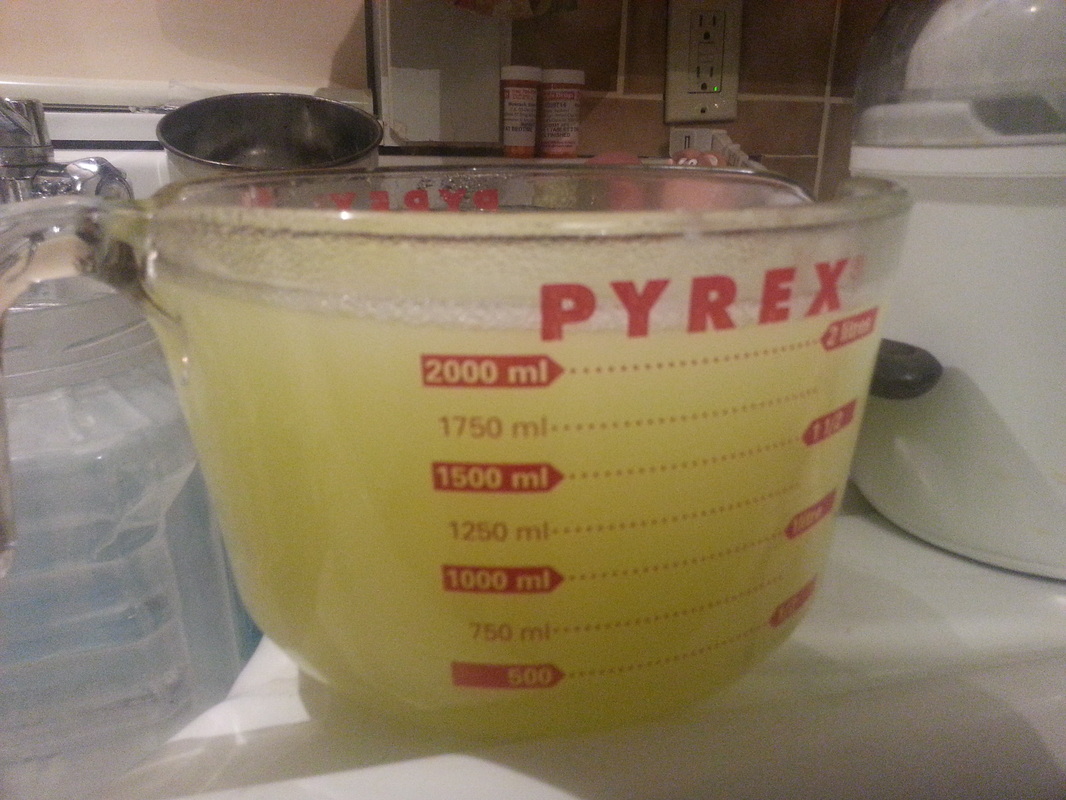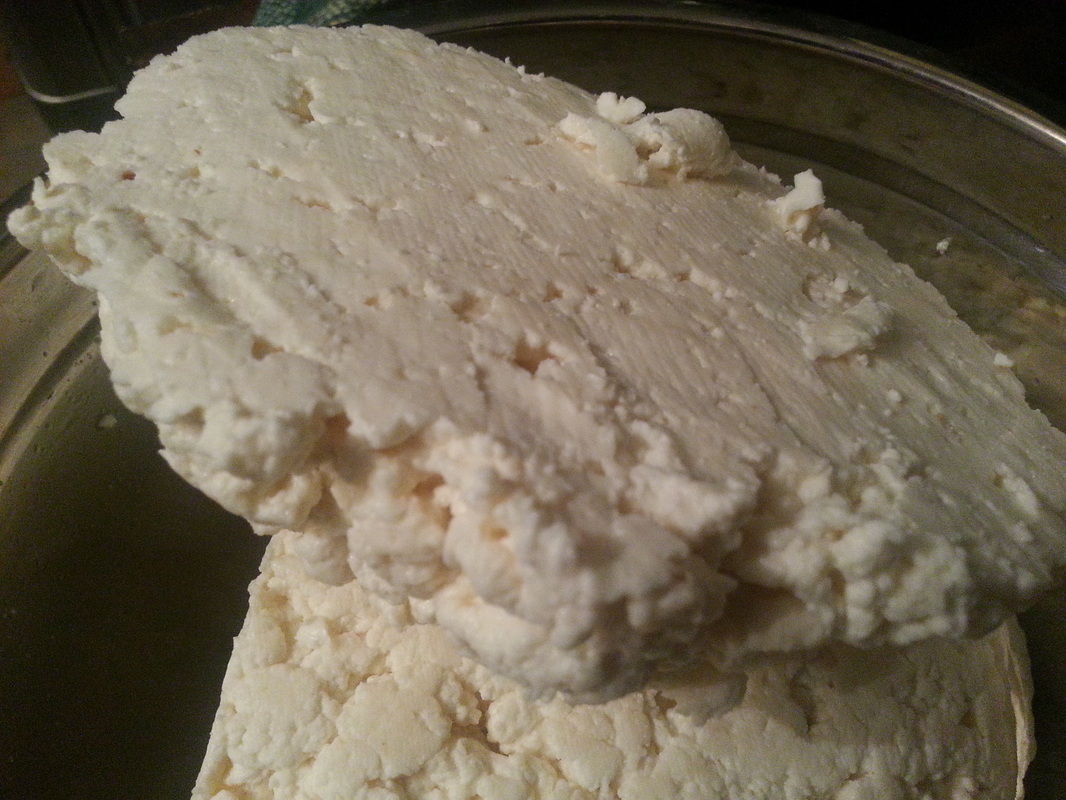I used a total of 4 gallons of whole rich milk to make the cheese, a half gallon to make the yogurt and froze the other half of gallon for soap. That was a fiasco, because one of the bags dropped to the second shelf in the freezer, popped open, spilled all over and leaked out onto the floor. I called the first alert floor cleaning service, aka, Robbie the wonder dog, who did his best to lick up the spilled milk on the porch floor, but there was still a lot of cleaning to do. The milk spilled in the freezer was already frozen onto whatever it touched and I gave up on that for the time being.
The four and a half gallons of fresh raw milk was put into a 5 gallon pot, my father's old bread machine pot, on the gas stove and turned on medium. At first I did not worry much about it, and just gave it the occasional stir. An hour later it was only as 92degrees Farenheit and it needed to reach 180. This took almost 3 hours! Towards the end I turned the heat on almost high and stood there stirring vigilantly. Finally, the temperature was 180.
Then I removed the milk for yogurt, which had to cool to 80 degrees Farenheit so it would not kill the yogurt live culture that would be stirred in, really, just some organic yogurt from the store. That waited while the huge pot of scalding milk got introduced to 2 cups of vinegar. I had also added a handful of salt earlier. The vinegar immediately separated the milk into strings, not curds, and I kept stirring as per the instructions I was following. The strings went to the bottom of the pot and rather than try to lift and pour, I scooped whey out into other vessels to be given to the pigs and dogs later.
When the majority of whey was removed, I turned the pot into a colander fit with cheesecloth and then twisted the cloth to squish the remaining whey. This resulted in a ball of semi soft but stuck together cheese with absolutely no flavour and a texture like a rubber ball. I later learned the reason that this could have happened. One, the vinegar was added too hot, though the directions said add it when it reached 180F. The other is that I disturbed the milk protein by continuing to stir, but again, that was following directions. Apparently rubbery tasteless cheese is good melted on vegetables, so I will give it a try. The next day, the flavour had improved somewhat, but the zing was missing.
The yogurt milk cooled enough to add the yogurt and the culture (store bought organic yogurt) was added, then half was put in the yogurt maker and the other half in the over with the light on. The one in the oven did nothing, but almost 24 hours later the yogurt in the yogurt maker was wonderful. I ate lots of it warm. I know, warm yogurt!!! But it was really great. Then I dumped it into a strainer to make yogurt cheese, which was 100 times better than the vinegar cheese and the volume was more too, with less whey waste. I think in the future I will find a method to make yogurt in a large volume and then make yogurt cheese. The cultured milk had that zing one expects to find with any cheese and the texture was much like crumbly cottage cheese, but totally delicious. I put the milk that was in the oven into the yogurt maker to finish it for tomorrow.
The frozen milk is slated for that delectable bar soap, maybe tomorrow if I get the house cleaned enough for soaping. I did buy a vacuum for the farmhouse today since my good vaccuum is over at the Inn and I hate carting it back and forth in winter. There is still wool on the kitchen table and the wool picker, so I guess I will have to put that project on hold for now and move on to soaping next.
There will be more cheese making in the future with the proper cultures. This vinegar method is an old fashioned way to make basic farmer's cheese and I don't think I will be making it again anytime soon. It took just over 3 hours from start to finish for a couple of pounds of rubbery, tasteless cheese and a big mess from all the work!
On to the next project soon…stay tuned!







 RSS Feed
RSS Feed